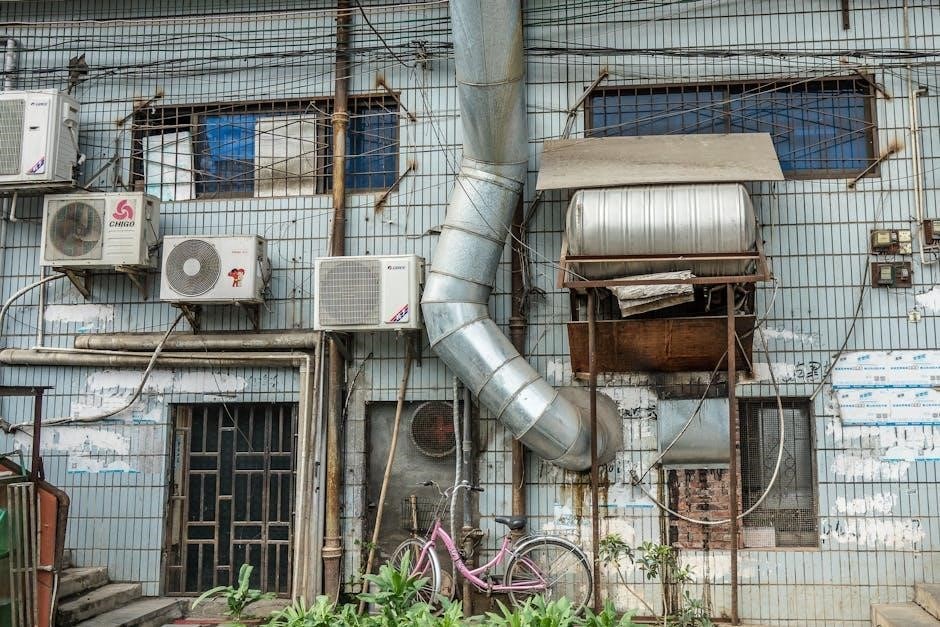Refrigeration and air conditioning technology involves thermodynamic principles to control temperature and humidity, essential for industrial, residential, and commercial applications, ensuring energy efficiency and environmental sustainability.
1.1 Overview of Refrigeration and Air Conditioning Systems
Refrigeration and air conditioning systems are thermodynamic processes that control temperature and humidity. They involve compressors, condensers, evaporators, and expansion valves to transfer heat. These systems are essential for industrial cooling, food preservation, and climate control in residential and commercial spaces, ensuring energy efficiency and environmental sustainability while maintaining optimal performance across various applications.
1.2 Historical Development and Modern Applications
Refrigeration and air conditioning technology traces its roots to early innovations in thermodynamics, evolving from toxic gases to modern, eco-friendly refrigerants. Initially used for food preservation, these systems now play a vital role in industries, healthcare, and residential comfort. Modern applications include advanced HVAC systems, industrial cooling, and smart energy-efficient solutions, driving global advancements in sustainability and energy management.

Fundamentals of Cooling and Heat Transfer
Cooling and heat transfer are rooted in thermodynamic principles, involving conduction, convection, and radiation. These processes enable efficient energy transfer, crucial for refrigeration and air conditioning systems’ operation.
2.1 Thermodynamic Principles and Energy Balance
Thermodynamic principles, such as the first and second laws, govern energy interactions in cooling systems. Energy balance ensures efficient conversion and transfer, minimizing losses. These principles are fundamental to designing and optimizing refrigeration and air conditioning systems, enabling precise temperature control and maximizing overall system performance while maintaining environmental sustainability. Understanding these concepts is crucial for system efficiency and effectiveness.
2.2 Heat, Temperature, and Modes of Heat Transfer
Heat transfer occurs through conduction, convection, and radiation, essential for cooling systems. Temperature measures the thermal energy of particles, while heat is energy transfer due to temperature differences. Understanding these principles is critical for designing efficient refrigeration and air conditioning systems, as they directly impact system performance, energy consumption, and overall sustainability in various applications.

Key Components of Refrigeration Systems
Refrigeration systems rely on compressors, condensers, evaporators, and expansion valves. These components work together to facilitate the refrigeration cycle, enabling heat transfer and cooling efficiently.
3.1 Compressors, Condensers, and Evaporators
Compressors compress refrigerant, raising its temperature and pressure. Condensers transfer heat from the refrigerant to the environment, while evaporators absorb heat, cooling the surrounding air. Together, these components form the heart of refrigeration systems, ensuring efficient heat transfer and cooling processes across various applications.
3.2 Expansion Valves and Refrigerant Flow Control
Expansion valves reduce refrigerant pressure, regulating flow into the evaporator. They ensure the proper vapor-liquid mixture, optimizing heat absorption. Accurate control of refrigerant flow is critical for system efficiency and performance, preventing overcharging or undercharging, which can lead to reduced cooling capacity and increased energy consumption.

Refrigerants and Their Environmental Impact
Refrigerants play a crucial role in cooling systems but pose environmental risks like ozone depletion and global warming. Sustainable alternatives, such as CO2 and natural refrigerants, are increasingly adopted.
4.1 Types of Refrigerants and Their Properties
Refrigerants are categorized into natural and synthetic types. Natural refrigerants, such as CO2 and hydrocarbons, offer zero ozone depletion but require high-pressure systems. Synthetic refrigerants like R-32 provide improved performance with lower environmental impact compared to traditional options. Each type balances thermodynamic properties with environmental concerns, driving sustainable cooling solutions.
4.2 Environmental Concerns and Sustainable Alternatives
The phase-out of ozone-depleting refrigerants like CFCs and HCFCs has driven the adoption of eco-friendly alternatives. Natural refrigerants such as CO2 and ammonia are gaining popularity due to their zero ozone depletion potential. Additionally, synthetic blends like HFOs offer low global warming potential solutions. These sustainable options align with global efforts to reduce environmental impact while maintaining system efficiency and performance.

System Design and Optimization
System design and optimization focus on principles like benchmarking to enhance efficiency and performance in cooling applications, ensuring reliability and adaptability to various operational demands.
5.1 Design Principles for Efficient Cooling Systems
Efficient cooling systems rely on optimal component sizing, proper airflow management, and smart refrigerant flow control. Advanced technologies like variable-speed compressors and intelligent sensors enhance performance, reducing energy consumption and operational costs. These designs ensure consistent cooling while adhering to environmental standards, making them suitable for both industrial and residential applications.
5.2 Benchmarking and Performance Evaluation
Benchmarking evaluates cooling system efficiency by comparing performance metrics like energy consumption and cooling capacity. This process ensures systems meet sustainability standards and operational goals. Advanced diagnostic tools and performance metrics help identify inefficiencies and optimize system design. Regular benchmarking supports continuous improvement, ensuring systems remain energy-efficient and environmentally compliant, aligning with modern cooling technologies.
Applications in Industrial and Residential Settings
Industrial cooling systems, like chillers, are crucial for manufacturing and food storage. Residential solutions include air conditioning and smart refrigeration, enhancing comfort and energy efficiency in homes.
6.1 Industrial Cooling Systems and Chillers
Industrial cooling systems, including chillers, are vital for maintaining optimal temperatures in manufacturing processes and large-scale storage. They ensure precise control over cooling, preventing equipment overheating and maintaining product quality. Chillers, often water-cooled or air-cooled, are widely used in industries like food processing, pharmaceuticals, and chemicals. Their efficient operation is crucial for productivity, safety, and energy conservation in industrial settings.
6.2 Residential Air Conditioning and Refrigeration Solutions
Residential air conditioning and refrigeration systems are designed for comfort and food preservation in homes. These systems often include split units, window ACs, and refrigerators. Energy-efficient solutions, such as smart thermostats and eco-friendly refrigerants, are increasingly popular. Proper sizing and installation ensure optimal performance, reducing energy consumption while maintaining indoor air quality and temperature control for households.

Advanced Technologies and Innovations
Modern advancements include smart HVAC systems, inverter-driven compressors, and eco-friendly refrigerants, enhancing energy efficiency and sustainability in cooling technologies while reducing environmental impact significantly.
7.1 Heat Pumps and Their Role in Modern Systems
Heat pumps are increasingly popular, offering efficient heating and cooling by transferring heat between systems. They enhance energy efficiency, reduce emissions, and are versatile in various applications. Modern designs integrate advanced compressors and smart controls, optimizing performance. Their role in sustainable HVAC solutions is pivotal, aligning with global efforts to improve energy efficiency and reduce environmental impact significantly.
7.2 Smart and Energy-Efficient Cooling Solutions
Smart cooling technologies integrate IoT, AI, and machine learning to optimize energy use. Advanced systems monitor temperature, humidity, and airflow, adapting to demand. Inverter-driven compressors and smart thermostats enhance efficiency. These solutions reduce energy consumption and emissions, promoting sustainability. Benchmarking and performance tracking ensure optimal operation, aligning with global goals for energy efficiency and environmental conservation in modern HVAC systems.

Maintenance and Troubleshooting
Maintenance involves routine inspections, cleaning, and checking refrigerant levels. Common issues include leaks and compressor failures. Diagnostic tools and techniques ensure efficient system operation and longevity.
8.1 Best Practices for System Maintenance
Regular inspections and cleaning of components like condensers and evaporators ensure optimal performance. Checking refrigerant levels, electrical circuits, and lubrication systems prevents failures. Using diagnostic tools helps identify issues early, while benchmarking performance ensures energy efficiency. Proper maintenance extends equipment lifespan, reduces operational costs, and maintains reliability in cooling systems.
8.2 Common Issues and Diagnostic Techniques
Common issues include refrigerant leaks, compressor failures, and sensor malfunctions. Diagnostic techniques involve pressure-temperature analysis, flow meter testing, and electrical circuit checks. Advanced tools like thermodynamic analyzers and leak detectors help identify system inefficiencies. Early detection of these issues ensures reliable operation, reduces downtime, and prevents costly repairs in refrigeration and air conditioning systems.
Education and Training in HVAC Technology
Education and training in HVAC technology provide hands-on experience and real-world applications, preparing students for successful careers in heating, air conditioning, and refrigeration industries.
9.1 Course Offerings and Skill Development
Course offerings in HVAC technology cover thermodynamic principles, electrical circuits, and refrigeration systems. Students develop skills in system design, troubleshooting, and energy efficiency, preparing them for industry-recognized certifications and hands-on roles in heating, air conditioning, and refrigeration. Practical training ensures proficiency in installing, maintaining, and optimizing HVAC systems, aligning with modern industry standards and safety protocols.
9.2 Laboratory Training and Practical Applications
Laboratory training emphasizes hands-on experience with HVAC systems, allowing students to apply theoretical knowledge in real-world scenarios. Practical applications include diagnosing and troubleshooting systems, operating compressors, and designing efficient cooling solutions. Students engage in projects like sizing heating and cooling systems, ensuring compliance with industry standards and safety protocols, while gaining proficiency in using specialized tools and equipment.
Refrigeration and air conditioning technology continues to evolve, focusing on energy efficiency, sustainability, and innovation. Future trends include advanced heat pumps, smart systems, and eco-friendly refrigerants, driving global energy savings and environmental stewardship.
10.1 Emerging Technologies and Industry Growth
Emerging technologies like smart HVAC systems, eco-friendly refrigerants, and advanced heat pumps are revolutionizing the industry. These innovations enhance energy efficiency, reduce environmental impact, and meet growing demand for sustainable cooling solutions, driving industry growth and adoption of cleaner technologies globally.
10.2 The Role of Refrigeration in Global Energy Efficiency
Refrigeration plays a crucial role in global energy efficiency by optimizing cooling processes and reducing energy consumption. Advanced systems minimize environmental impact while maintaining performance, contributing to sustainable development and supporting industries worldwide. This ensures energy resources are used effectively, aligning with global efforts to reduce carbon emissions and promote eco-friendly technologies.
